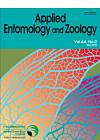Volume 39, Issue 2
Displaying 1-22 of 22 articles from this issue
- |<
- <
- 1
- >
- >|
Regular Papers
-
2004 Volume 39 Issue 2 Pages 195-202
Published: 2004
Released on J-STAGE: August 25, 2004
Download PDF (414K) -
Insecticide susceptibility of the leafminer, Chromatomyia horticola (Goureau) (Diptera: Agromyzidae)2004 Volume 39 Issue 2 Pages 203-208
Published: 2004
Released on J-STAGE: August 25, 2004
Download PDF (51K) -
2004 Volume 39 Issue 2 Pages 209-216
Published: 2004
Released on J-STAGE: August 25, 2004
Download PDF (1558K) -
2004 Volume 39 Issue 2 Pages 217-219
Published: 2004
Released on J-STAGE: August 25, 2004
Download PDF (41K) -
2004 Volume 39 Issue 2 Pages 221-228
Published: 2004
Released on J-STAGE: August 25, 2004
Download PDF (217K) -
2004 Volume 39 Issue 2 Pages 229-233
Published: 2004
Released on J-STAGE: August 25, 2004
Download PDF (285K) -
2004 Volume 39 Issue 2 Pages 235-241
Published: 2004
Released on J-STAGE: August 25, 2004
Download PDF (76K) -
2004 Volume 39 Issue 2 Pages 243-248
Published: 2004
Released on J-STAGE: August 25, 2004
Download PDF (1726K) -
2004 Volume 39 Issue 2 Pages 249-254
Published: 2004
Released on J-STAGE: August 25, 2004
Download PDF (403K) -
2004 Volume 39 Issue 2 Pages 255-261
Published: 2004
Released on J-STAGE: August 25, 2004
Download PDF (71K) -
2004 Volume 39 Issue 2 Pages 263-269
Published: 2004
Released on J-STAGE: August 25, 2004
Download PDF (112K) -
2004 Volume 39 Issue 2 Pages 271-277
Published: 2004
Released on J-STAGE: August 25, 2004
Download PDF (71K) -
2004 Volume 39 Issue 2 Pages 279-282
Published: 2004
Released on J-STAGE: August 25, 2004
Download PDF (46K) -
2004 Volume 39 Issue 2 Pages 283-292
Published: 2004
Released on J-STAGE: August 25, 2004
Download PDF (2167K) -
2004 Volume 39 Issue 2 Pages 293-302
Published: 2004
Released on J-STAGE: August 25, 2004
Download PDF (118K) -
2004 Volume 39 Issue 2 Pages 303-309
Published: 2004
Released on J-STAGE: August 25, 2004
Download PDF (212K) -
2004 Volume 39 Issue 2 Pages 311-314
Published: 2004
Released on J-STAGE: August 25, 2004
Download PDF (66K) -
2004 Volume 39 Issue 2 Pages 315-320
Published: 2004
Released on J-STAGE: August 25, 2004
Download PDF (209K) -
2004 Volume 39 Issue 2 Pages 321-326
Published: 2004
Released on J-STAGE: August 25, 2004
Download PDF (173K) -
2004 Volume 39 Issue 2 Pages 327-333
Published: 2004
Released on J-STAGE: August 25, 2004
Download PDF (303K) -
2004 Volume 39 Issue 2 Pages 335-341
Published: 2004
Released on J-STAGE: August 25, 2004
Download PDF (345K) -
2004 Volume 39 Issue 2 Pages 343-349
Published: 2004
Released on J-STAGE: August 25, 2004
Download PDF (63K)
- |<
- <
- 1
- >
- >|
